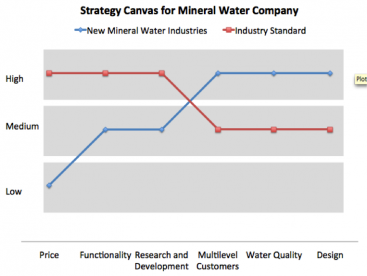The Blue/Red Ocean Strategy is a way of assessing your business against your competitors in order to identify your competitive advantage. It is based on the notion that there are two types of market places: blue oceans (where competition is irrelevant) and red oceans (where competition is high and businesses must fight for available resources). By identifying the “blue oceans” for your business, you can focus on gaining a market share in those areas where you excel rather than areas that are already saturated with competition.
To run a successful business, you must compete with other businesses to gain a foothold in the market. Understanding how you measure up to competition is critical not only in where you might be weaker, but also in strategically taking advantage of those areas where competition is weaker or nonexistent. These areas are referred to as your competitive advantage. One strategy to help you assess your competitive advantage is called the Blue Ocean Strategy.
Imagine amarket universe composed of two sorts of oceans: red oceans andblue oceans. Inred oceans, companiestry to outperform their rivals to grab a greater share of existing demand. As the market space gets crowded, prospects for profits andgrowth are reduced. Products become commodities, and cut-throatcompetition turns the red ocean bloody.
Blue oceans, in contrast, are defined by untapped market space,demand creation, and the opportunity for highly profitable growth.In blueoceans, competition is irrelevant because the rules of the game arewaiting to be set.
Generally, the following characteristics distinguish blue from red oceans:
| Red Ocean Strategy | Blue Ocean Strategy |
| Compete in existing market space | Create uncontested market space |
| Beat the competition | Make the competition irrelevant |
| Exploit existing demand | Create and capture new demand |
| Make the value-cost trade-off | Break the value-cost trade-off |
| Align the whole system of a firm’s activities with its strategic choice of differentiation or low cost | Align the whole system of a firm’s activities in pursuit of differentiation and low cost |
 Strategy Canvas_medium.png)
Strategy Canvas layout. Source: BLUE OCEAN STRATEGY 2012
The Blue Ocean Strategy Canvas is a useful tool to find the competitive advantage of your start-up by identifying and evaluating how your start-up competes against industry values (e.g. your competitor).
To create a strategy canvas for your start-up, follow these steps:
- Draw a large graph with one horizontal and one vertical axis. The horizontal axis will be the “competing factors” and the vertical axis will be the “offering level.” “Competing factors” are the value propositions you offer (see business model canvas and “offering level” is a rating of your ability to deliver that value compared to your competitors.
- Create a list of 10-15 value propositions of your business. Some examples could include price, marketing, customer service quality, product quality, etc. Label these factors along the horizontal axis (see business model canvas for more information about value propositions).
- For each factor, rate both your business and your competition as “high,” “medium” or “low.” Mark your business in blue and the industry value in red For example, if your value proposition is “low prices,” yet your competitor offers a lower price than your business, your offering level should be lower than the industry value’s.
Once you’ve plotted how you measure up to competition for each factor, it should be relatively easy to see where your competitive advantage lies. The figure below depicts an example of a strategy canvas for a mineral water company. This strategy canvas clearly shows that this company’s competitive advantage lies in its multilevel customer base, its product’s water quality, and its design. This mineral water company can now form strategies tomake use of its competitive advantage rather than try to compete with the competition for red-ocean factors like price, functionality, or amount of research and development.

Example of a strategy canvas for a mineral water company. Adapted from: ECO MAX 2012
As demonstrated above, by identifying the “blue oceans” for your business, you can focus on gaining a market share in those areas where you excel rather than areas that are already saturated with competitors, thus increasing the likelihood that your business will be a success.
Blue Ocean Strategy in Asia. Case 2
This article evaluates a blue ocean strategy canvas for the mineral water industry in Asia. By using the strategy canvas, four actions were identified for companies to come out from red ocean, to make competition irrelevant.
ECO MAX (2012): Blue Ocean Strategy in Asia. Case 2. Eco Max Training and Learning Centre URL [Accessed: 16.01.2013]Blue Ocean Strategy
This presentation discusses the theory behind the Blue Ocean Strategy as well as examples and statistics demonstrating successful business development in blue oceans.
ZOHAR, D. (n.y): Blue Ocean Strategy. SIMPLE Management Consulting: URL [Accessed: 16.01.2013]Blue Ocean Strategy in Asia. Case 2
This article evaluates a blue ocean strategy canvas for the mineral water industry in Asia. By using the strategy canvas, four actions were identified for companies to come out from red ocean, to make competition irrelevant.
ECO MAX (2012): Blue Ocean Strategy in Asia. Case 2. Eco Max Training and Learning Centre URL [Accessed: 16.01.2013]Blue Ocean Strategy. How to Create Uncontested Market Space and Make the Competition Irrelevant
This book gives a wealth of information about the Blue Ocean Strategy, examples, and guidance on using the strategy canvas to identify the competitive advantage in a business.
KIM, W.C. MAUBORGNE, R. (2005): Blue Ocean Strategy. How to Create Uncontested Market Space and Make the Competition Irrelevant. Boston: Harvard Business School Press URL [Accessed: 13.01.2013]Blue Ocean Strategy
This presentation discusses the theory behind the Blue Ocean Strategy as well as examples and statistics demonstrating successful business development in blue oceans.
ZOHAR, D. (n.y): Blue Ocean Strategy. SIMPLE Management Consulting: URL [Accessed: 16.01.2013]http://www.blueoceanstrategy.com/
This website contains a wealth of information about the blue ocean strategy, as well as many tips and downloads available for using the blue ocean strategy to improve your business.
http://www.insead.edu/
This website provides articles, academic articles, course materials and other resources for making use of the Blue Ocean Strategy.
cewas - The business and integrity experts in the water sector
cewas is a Swiss-based international centre of competence in the field of sustainable sanitation and water resource management. It combines advanced education with a start-up centre, a think tank, and a business platform.



